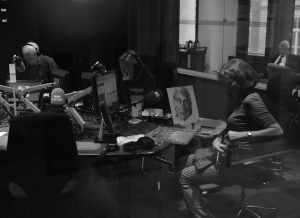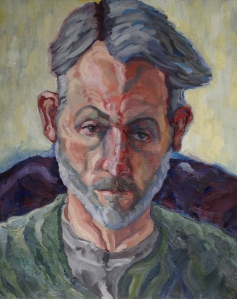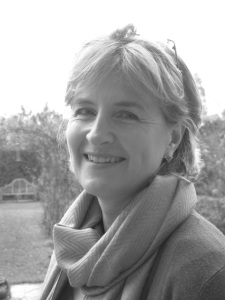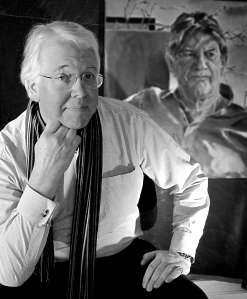Over the next month or so we will be blogging about individual members of the lots road group. To start with we have the fabulous journalist turned painter Stella Tooth pictured below:

Stella Tooth painting John Humphrys
A Chat With Stella:
After more than 20 years as a London based journalist and broadcast news pr, you decided to change your blackberry for a paintbrush. Why did you decide to reinvent yourself as a figurative artist mid-life?
Although always artistic, I opted to pursue art as a hobby, after leaving college and university, and made my living, instead, first as a journalist and then as a broadcast news PR. My interest in art was fed by taking evening classes in life drawing and painting. Around 2007 I found that was not enough. A friend introduced me to Heatherley’s School of Fine Art in Chelsea – a school which specialises in figurative art, where Walter Sickert and Michael Ayrton trained. I was heading up publicity for Sky News at the time and I shifted my hours to undertake a portfolio course. My art began to take off, my confidence grew and I was soon hooked! About a year before I left Sky I discovered my portfolio had won me a place on the school’s two year Portraiture Diploma. I talked it over with my husband, Nigel, and we decided I should go for it. I completed the Post Diploma in July 2013 and have been taking portrait commissions throughout. I am now a tutor myself for Sketchout, which provides dynamic drawing classes at the V & A , The Tate Britain, the National Portrait Gallery and The Courtauld. http://www.sketchout.net/
Which other artists or painters do you look to for inspiration and why?
Figurative art was out of fashion for some time – since Picasso. But there is a renewed interest in it in the UK and, as a British painter, painting in the context of British art, I’m delighted to have the pioneering work of Bacon, Freud, Hockney, Rego, Spencer and more recently Jenny Saville and Ian Drury to look to. I also love the photographic portraits of David Bailey.
What, to you, constitutes a good portrait?
I see a portrait as a collaboration between the sitter and the artist who, like a broadcast journalist, provides a filter for the viewer. Those who sit for me surrender their faces to be painted as I see them not, as in a photograph, at a moment in time, but at this point in their life. So I seek to not just record body language and expression, but to provide an insight into the sitter’s character and life experience.
What has been your most interesting experience as a figurative artist so far?
In 2013 I was among 50 international artists selected to take part in the first Egypt art biennale in Sharm el Sheikh, along with three other artists. The biennale was run under the auspices of three Egyptian ministries: tourism, culture and foreign, with the aim of supporting tourism in the region. During our 10 day stay, we were asked to paint in public – in the town square, inspired by spectacular ‘whirling dervish’ and fire eating performances, in the desert nightclub housed inside a cave ‘La Dolce Vita’ and in the bustling Naama Bay shopping area.
In the grounds of the Sonesta Beach Hotel, where we stayed, we were visited by a stream of ministers as we each painted two 70x80cms pictures for the competition. The pictures were judged at the end of our stay by a panel of international judges, with prizes awarded at a televised gala evening attended by European and Middle Eastern art critics in the landscaped grounds of Le Royal Hotel Resort. Selected pictures then went on show at the hotel until Christmas. The closing night reception, with performances by Egypt’s best known singers and dancers, was attended by the Admiral Governor of South Sinai (whose portrait I was asked to paint). Pierangelo Arbosti was the overall biennale winner and my fellow London artists Rohan Samuel and Annalisa Colombara came 2nd and 5th respectively with Annamaria Dzendrowskyj receiving a biennale plaque. Italian artist Archille Quadrini and I won the Judges’ prizes.
I have to say it was an absolutely exhausting, yet exhilarating, experience to paint alongside other artists from Europe and the Middle East – specialists in watercolour, in oils, in figurative, landscape or abstract art. We had the chance to exchange ideas, to learn new techniques, from the showy display of burning gold leaf onto canvas to the texturising of paint by mixing sand into it. We realised quite quickly that all of us were products of our own, distinct cultural traditions. And, of course, the experience of being part of a shared endeavour gave rise to a camraderie that has produced a lasting legacy of being part of a supportive community of artist friends.

The Hod Carrier, Stella Tooth, oil on canvas, 80x70cms
Do you have any current projects that you’d like to tell us about (exhibitions, articles, websites, commissions, personal projects)?
BROADCAST NEWS JOURNALIST SERIES:
As an ex journalist & news PR, I have begun exploring the on and off air personas of news broadcasters, as a way of uniting my past and present careers. At the BBC and Sky News, I spent a fair amount of my working life looking after the public image of some of the UK’s best known news journalists. I’ve been working on a series of more personal images of them, using the limited amount of time they can give me in their high-pressured working lives to paint colour studies and take reference photos of them in their workplace or in their home studies. So far I have painted BBC Radio 4 Today Presenter John Humphrys at work in Today studio – a first for the show, as they had never had an artist painting live on air! I also painted then ITV News at 10 Presenter Julie Etchingham, who I met at Sky, in the home study where she prepped for the Royal Wedding and caught former BBC Chief Correspondent Kate Adie, who now presents BBC Radio 4’s From Our Own Correspondent, at the BBC, in between her commitments to promote her new book The Legacy of Women in World War One. Sky News’ former Political Editor Adam Boulton sat for me at his home, just before he moved to a new flat and to a new job as presenter of the channel’s new flagship evening programme. And George Alagiah, who presents BBC Six O’Clock News and GMT on BBC World Service, has sat for me at New Broadcasting House.
What did they think of the experience? Humphrys said: “It’s rather odd having someone do your portrait while you’re working. They say the camera never lies..sadly, neither does the artist. I rather hoped she might iron out the wrinkles!” Etchingham said: “Being scrutinised by an artist’s eye is a world away from sitting in front of a news camera – a far more personal and exposed experience – but the fact I know how gentle and endearing Stella is made it an altogether easier time than I’d imagined.” And Boulton said: “Because we are looking out from ourselves most of us don’t know what we really look like let alone what impression we make – a portrait is the best way to find out and Stella has an artist’s eye and professional insight when it comes to people from the media world like me.”
When I have completed the project if the National Portrait Gallery, set up to record eminent Victorians, happened to come a callin’ I certainly wouldn’t have any problems with that!
PERFORMERS SERIES:
My other art stems from curiosity about those with whom we share this global village, particularly the melting pot that is London. With a lifetime’s passion for reportage, I tell the stories of the buskers, musicians and dancers that inspire my art, exploring themes of separation and connection. Fascinated in the interplay between illustration and fine art, I seek to blur their boundaries.
Many thanks Stella!
You can see more of Stella’s fabulously bold and engaging work via her website and her Brighton-based dealer Kellie Miller Arts.
(all images and text copyright thelotsroadgroup 2014, please ask permission before use)







